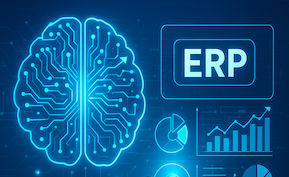Artificial Intelligence
ERP
Vendor Comparison: SAP vs Microsoft vs Oracle AI ERP Solutions

Selecting the right AI ERP vendor represents one of the most critical technology decisions organizations will make. SAP, Microsoft, and Oracle have emerged as the leading enterprise AI ERP providers, each offering distinct approaches to artificial intelligence integration and business process optimization. This comprehensive analysis provides detailed comparison across functionality, AI capabilities, implementation approach, and total cost of ownership.
Executive Summary: Vendor Positioning
SAP S/4HANA with Joule AI: Market leader in AI sophistication with the most advanced natural language processing and autonomous business process capabilities. Best suited for large enterprises requiring cutting-edge AI functionality.
Microsoft Dynamics 365 with Copilot: Integration champion leveraging the broader Microsoft ecosystem including Office 365, Teams, and Azure. Optimal for organizations already invested in Microsoft technologies.
Oracle Cloud ERP with AI: Database and analytics powerhouse providing superior data processing capabilities and industry-specific functionality. Ideal for data-intensive organizations requiring advanced analytics.
Detailed Vendor Analysis
SAP S/4HANA with Joule AI
Market Position:
SAP leads the enterprise ERP market with the most sophisticated AI capabilities currently available. Joule AI represents the most advanced natural language interface in the enterprise software industry.
Core AI Capabilities:
Joule AI Copilot:
- Knowledge Graph Integration: Access to 450,000+ database tables providing comprehensive business context
- Cross-System Intelligence: Seamless integration across all SAP applications with unified AI experience
- Natural Language Processing: Conversational interaction with complex business data and processes
- Autonomous Operations: AI handles sophisticated business processes with minimal human oversight
Document Processing:
- 98%+ accuracy in invoice, purchase order, and contract processing
- Automated approval routing based on business rules and historical patterns
- Intelligent exception handling with human escalation protocols
- Multi-language document processing capabilities
Predictive Analytics:
- Advanced demand forecasting incorporating external data sources
- Predictive maintenance with IoT sensor integration
- Customer churn prediction and intervention recommendations
- Financial forecasting and cash flow optimization
Industry-Specific Intelligence:
- Manufacturing: Production optimization and quality control
- Retail: Inventory management and customer behavior analysis
- Services: Resource optimization and project profitability prediction
Implementation Considerations:
- Timeline: 6-18 months for comprehensive implementation
- Complexity: High technical sophistication requiring dedicated IT resources
- Change Management: Significant organizational change management investment required
- Customization: Extensive customization options but complexity increases cost and timeline
Total Cost of Ownership (3-Year Analysis):
- Software Licensing: $150-250 per user per month
- Implementation Services: $500K-$5M+ depending on organizational complexity
- Training and Change Management: $200K-$1M
- Ongoing Support: 18-22% of license cost annually
- Total 3-Year TCO: $2M-$20M+ for enterprise implementations
Optimal Use Cases:
- Large enterprises ($100M+ annual revenue)
- Complex multi-entity organizations with global operations
- Companies requiring cutting-edge AI capabilities
- Organizations with dedicated IT teams and significant technical expertise
- Industries requiring sophisticated compliance and regulatory capabilities
Competitive Advantages:
- Most advanced AI capabilities in the market
- Comprehensive functionality across all business processes
- Strong industry-specific solutions and expertise
- Extensive global support and service organization
Potential Limitations:
- High complexity requiring significant technical expertise
- Expensive implementation and ongoing costs
- Long deployment timeline may delay benefits realization
- Steep learning curve for users transitioning from other systems
Microsoft Dynamics 365 with Copilot
Market Position:
Microsoft leverages its dominant position in productivity software and cloud infrastructure to provide seamlessly integrated AI ERP capabilities across the entire Microsoft ecosystem.
Core AI Capabilities:
Copilot Integration:
- Office 365 Integration: Native AI assistance within familiar Microsoft applications
- Teams Collaboration: AI-powered project management and communication
- PowerBI Analytics: Advanced business intelligence with natural language queries
- Azure AI Services: Access to Microsoft’s comprehensive AI platform
Business Process Automation:
- Intelligent workflow automation across multiple Microsoft applications
- Document processing integrated with SharePoint and Office applications
- Customer relationship management with AI-powered insights and recommendations
- Financial management with automated reconciliation and forecasting
Predictive Intelligence:
- Sales forecasting with CRM data integration
- Customer behavior analysis and segmentation
- Supply chain optimization with demand forecasting
- Financial performance prediction and optimization
Low-Code/No-Code Development:
- PowerApps platform for custom application development
- PowerAutomate for process automation and integration
- PowerBI for self-service analytics and reporting
- Citizen developer capabilities reducing IT dependency
Implementation Considerations:
- Timeline: 3-12 months with faster deployment for Microsoft-centric organizations
- Complexity: Moderate complexity with familiar Microsoft interface reducing training requirements
- Integration: Seamless integration with existing Microsoft infrastructure
- Scalability: Flexible scaling options accommodating growth requirements
Total Cost of Ownership (3-Year Analysis):
- Software Licensing: $100-180 per user per month
- Implementation Services: $200K-$2M depending on customization requirements
- Training and Change Management: $100K-$500K
- Microsoft 365 Integration: Additional $10-30 per user per month
- Total 3-Year TCO: $1M-$10M for mid-size to large implementations
Optimal Use Cases:
- Organizations heavily invested in Microsoft technology stack
- Mid-size companies ($10M-$500M annual revenue) requiring balanced functionality and cost
- Companies prioritizing user adoption through familiar interfaces
- Organizations requiring strong integration with productivity and collaboration tools
- Businesses needing flexible customization without extensive technical expertise
Competitive Advantages:
- Seamless integration with Microsoft ecosystem
- Familiar user interface reducing training requirements
- Flexible deployment options (cloud, hybrid, on-premises)
- Strong low-code/no-code development platform
- Comprehensive productivity and collaboration integration
Potential Limitations:
- AI capabilities less sophisticated than SAP’s offering
- May require multiple Microsoft licenses increasing total cost
- Limited industry-specific functionality compared to specialized solutions
- Dependence on Microsoft ecosystem may limit technology flexibility
Oracle Cloud ERP with AI
Market Position:
Oracle leverages its database and analytics expertise to provide AI ERP solutions with superior data processing capabilities and industry-specific functionality.
Core AI Capabilities:
Database and Analytics Intelligence:
- Autonomous Database: Self-managing, self-securing, and self-repairing database infrastructure
- Advanced Analytics: Machine learning models integrated directly into business processes
- Data Lake Integration: Comprehensive data integration from multiple sources for AI analysis
- Real-Time Processing: High-performance transaction processing with immediate AI insights
Industry-Specific AI:
- Healthcare: Patient outcome prediction and regulatory compliance automation
- Financial Services: Risk assessment and regulatory reporting automation
- Manufacturing: Predictive maintenance and quality control optimization
- Retail: Customer behavior analysis and inventory optimization
Business Process Intelligence:
- Financial close automation with AI-powered reconciliation
- Procurement optimization with supplier performance analysis
- Human resources management with talent analytics and prediction
- Customer experience enhancement through behavioral analysis
Advanced Security:
- AI-powered threat detection and response
- Automated compliance monitoring and reporting
- Data privacy and protection with machine learning
- Security analytics and risk assessment
Implementation Considerations:
- Timeline: 4-15 months depending on customization and integration requirements
- Complexity: High technical sophistication but strong database foundation
- Data Integration: Superior capabilities for complex data integration scenarios
- Industry Expertise: Strong vertical industry knowledge and best practices
Total Cost of Ownership (3-Year Analysis):
- Software Licensing: $120-200 per user per month
- Implementation Services: $300K-$3M depending on customization and integration
- Training and Change Management: $150K-$750K
- Database and Infrastructure: Additional $50K-$500K annually
- Total 3-Year TCO: $1.5M-$15M for enterprise implementations
Optimal Use Cases:
- Data-intensive organizations requiring advanced analytics capabilities
- Companies with complex integration requirements across multiple systems
- Industries requiring sophisticated compliance and regulatory management
- Organizations prioritizing database performance and reliability
- Enterprises requiring extensive customization and vertical industry functionality
Competitive Advantages:
- Superior database and analytics capabilities
- Strong industry-specific functionality and expertise
- Advanced security and compliance features
- High-performance transaction processing
- Comprehensive data integration and management
Potential Limitations:
- Complex implementation requiring significant technical expertise
- Higher infrastructure costs due to database requirements
- User interface less intuitive compared to Microsoft solutions
- Limited ecosystem integration outside Oracle technology stack
Comprehensive Feature Comparison Matrix
| Capability | SAP S/4HANA + Joule | Microsoft Dynamics 365 + Copilot | Oracle Cloud ERP + AI |
|---|---|---|---|
| AI Sophistication | ⭐⭐⭐⭐⭐ Most Advanced | ⭐⭐⭐⭐ Strong Integration | ⭐⭐⭐⭐ Analytics Focus |
| Natural Language Interface | ⭐⭐⭐⭐⭐ Industry Leading | ⭐⭐⭐⭐ Familiar Experience | ⭐⭐⭐ Basic Capabilities |
| Document Processing | ⭐⭐⭐⭐⭐ 98%+ Accuracy | ⭐⭐⭐⭐ Office Integration | ⭐⭐⭐⭐ Strong Processing |
| Predictive Analytics | ⭐⭐⭐⭐⭐ Comprehensive | ⭐⭐⭐⭐ PowerBI Integration | ⭐⭐⭐⭐⭐ Database Powered |
| Implementation Complexity | ⭐⭐ High Complexity | ⭐⭐⭐⭐ Moderate | ⭐⭐⭐ Complex |
| User Adoption | ⭐⭐⭐ Learning Curve | ⭐⭐⭐⭐⭐ Familiar Interface | ⭐⭐⭐ Oracle Experience |
| Total Cost | ⭐⭐ High Investment | ⭐⭐⭐⭐ Balanced Cost | ⭐⭐⭐ Moderate to High |
| Industry Capabilities | ⭐⭐⭐⭐⭐ Comprehensive | ⭐⭐⭐ General Business | ⭐⭐⭐⭐ Vertical Focus |
| Integration Ecosystem | ⭐⭐⭐⭐ SAP Ecosystem | ⭐⭐⭐⭐⭐ Microsoft Ecosystem | ⭐⭐⭐ Oracle Ecosystem |
| Scalability | ⭐⭐⭐⭐⭐ Enterprise Grade | ⭐⭐⭐⭐ Flexible Scaling | ⭐⭐⭐⭐ High Performance |
Implementation Timeline Comparison
SAP S/4HANA Implementation Timeline
- Months 1-3: Foundation setup and core configuration
- Months 4-9: Module implementation and integration
- Months 10-15: Testing, training, and go-live preparation
- Months 16-18: Go-live support and optimization
Microsoft Dynamics 365 Implementation Timeline
- Months 1-2: Setup and basic configuration
- Months 3-6: Module deployment and integration
- Months 7-9: User training and change management
- Months 10-12: Go-live and optimization
Oracle Cloud ERP Implementation Timeline
- Months 1-3: Infrastructure and database setup
- Months 4-8: Application configuration and integration
- Months 9-12: Testing and user preparation
- Months 13-15: Deployment and stabilization
Industry-Specific Recommendations
Manufacturing Organizations
Recommended Solution: SAP S/4HANA with Joule AI
- Rationale: Most comprehensive manufacturing capabilities with advanced IoT integration and predictive maintenance
- Alternative: Oracle Cloud ERP for data-intensive manufacturing operations
- Budget Consideration: High investment justified by manufacturing complexity
Distribution and Wholesale
Recommended Solution: Microsoft Dynamics 365 with Copilot
- Rationale: Balanced functionality and cost with strong integration capabilities
- Alternative: SAP S/4HANA for large, complex distribution networks
- Budget Consideration: Mid-market sweet spot for cost-effectiveness
Professional Services
Recommended Solution: Microsoft Dynamics 365 with Copilot
- Rationale: Project management integration with Office 365 and Teams collaboration
- Alternative: Oracle Cloud ERP for consulting firms requiring advanced analytics
- Budget Consideration: Lower implementation cost suitable for services organizations
Healthcare and Life Sciences
Recommended Solution: Oracle Cloud ERP with AI
- Rationale: Superior compliance capabilities and industry-specific functionality
- Alternative: SAP S/4HANA for large healthcare systems requiring comprehensive integration
- Budget Consideration: Compliance requirements justify higher investment
Financial Services
Recommended Solution: Oracle Cloud ERP with AI
- Rationale: Advanced security, compliance, and risk management capabilities
- Alternative: SAP S/4HANA for large financial institutions with complex operations
- Budget Consideration: Regulatory requirements support premium solution investment
Decision Framework and Selection Criteria
Technical Evaluation Factors
- AI Capability Requirements: Assess the sophistication of AI features needed for competitive advantage
- Integration Complexity: Evaluate existing system landscape and integration requirements
- Data Volume and Complexity: Consider database performance and analytics requirements
- Scalability Needs: Plan for future growth and expansion requirements
- Security and Compliance: Assess regulatory and security requirements
Business Evaluation Factors
- Industry Requirements: Consider vertical-specific functionality and best practices
- Organizational Size and Complexity: Match solution capability to organizational needs
- Budget and ROI: Evaluate total cost of ownership against expected benefits
- Implementation Timeline: Consider urgency and business disruption tolerance
- User Adoption Requirements: Assess training and change management needs
Risk Assessment Factors
- Vendor Stability: Evaluate long-term viability and market position
- Technology Evolution: Consider platform flexibility and innovation capability
- Implementation Risk: Assess complexity and potential deployment challenges
- Total Cost Variability: Understand potential cost overruns and scope creep
- Competitive Positioning: Evaluate how solution choice affects market competitiveness
Conclusion and Recommendations
Choose SAP S/4HANA with Joule AI if:
- You require the most advanced AI capabilities available in the market
- Your organization is large and complex with sophisticated business requirements
- Budget allows for premium solution investment with high expected ROI
- You have dedicated technical resources for implementation and ongoing management
- Industry-specific functionality is critical for competitive advantage






